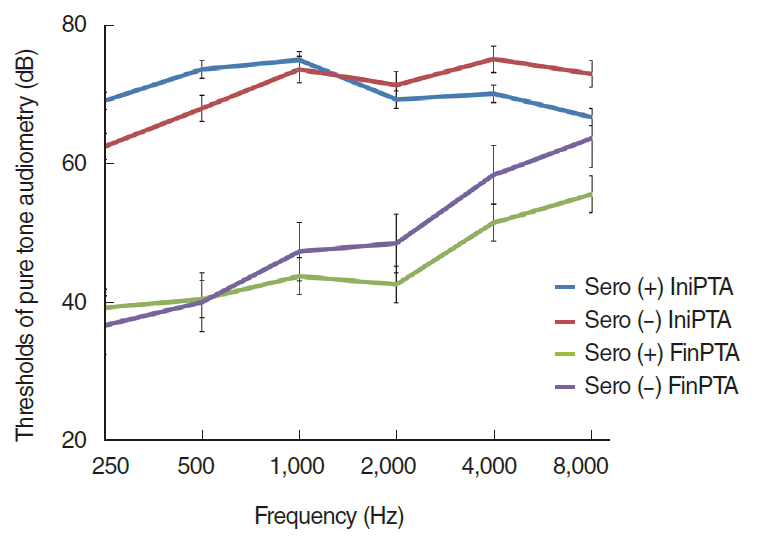1. Hughes GB, Freedman MA, Haberkamp TJ, Guay ME. Sudden sensorineural hearing loss. Otolaryngol Clin North Am. 1996; Jun. 29(3):393–405.

2. Van Dishoeck HA, Bierman TA. Sudden perceptive deafness and viral infection: report of the first one hundred patients. Ann Otol Rhinol Laryngol. 1957; Dec. 66(4):963–80.
3. Furuta Y, Takasu T, Fukuda S, Inuyama Y, Sato KC, Nagashima K. Latent herpes simplex virus type 1 in human vestibular ganglia. Acta Otolaryngol Suppl. 1993; 503:85–9.

4. Stokroos RJ, Albers FW, Schirm J. The etiology of idiopathic sudden sensorineural hearing loss: experimental herpes simplex virus infection of the inner ear. Am J Otol. 1998; Jul. 19(4):447–52.
5. Siegel LG. The treatment of idiopathic sudden sensorineural hearing loss. Otolaryngol Clin North Am. 1975; Jun. 8(2):467–73.

6. Wilson WR, Byl FM, Laird N. The efficacy of steroids in the treatment of idiopathic sudden hearing loss: a double-blind clinical study. Arch Otolaryngol. 1980; Dec. 106(12):772–6.

7. Chang DS, Park SW, Choi JY, Kim AY, Park KY, Cho CS, et al. Estimate hearing recovery rate using statistical analysis of sudden sensorineural hearing loss. Korean J Otorhinolaryngol-Head Neck Surg. 2011; Sep. 54(9):603–9.

8. Mattox DE, Lyles CA. Idiopathic sudden sensorineural hearing loss. Am J Otol. 1989; May. 10(3):242–7.
9. Yoshida Y, Yamauchi S, Shinkawa A, Horiuchi M, Sakai M. Immunological and virological study of sudden deafness. Auris Nasus Larynx. 1996; 23:63–8.

10. Vasama JP, Linthicum FH Jr. Idiopathic sudden sensorineural hearing loss: temporal bone histopathologic study. Ann Otol Rhinol Laryngol. 2000; Jun. 109(6):527–32.

11. Koide J, Yanagita N, Hondo R, Kurata T. Serological and clinical study of herpes simplex virus infection in patients with sudden deafness. Acta Otolaryngol Suppl. 1988; 456:21–6.

12. Gagnebin J, Maire R. Infection screening in sudden and progressive idiopathic sensorineural hearing loss: a retrospective study of 182 cases. Otol Neurotol. 2002; Mar. 23(2):160–2.

13. Schulz P, Arbusow V, Strupp M, Dieterich M, Rauch E, Brandt T. Highly variable distribution of HSV-1-specific DNA in human geniculate, vestibular and spiral ganglia. Neurosci Lett. 1998; Aug. 252(2):139–42.

14. Scalia G, Palermo CI, Maiolino L, Costanzo CM, Zappal D, Grillo C, et al. Detection of serum IgA to HSV1 and its diagnostic role in sudden hearing loss. New Microbiol. 2013; Jan. 36(1):41–7.
15. Schweinfurth JM, Parnes SM, Very M. Current concepts in the diagnosis and treatment of sudden sensorineural hearing loss. Eur Arch Otorhinolaryngol. 1996; 253(3):117–21.

16. Lee HS, Lee YJ, Kang BS, Lee BD, Lee JS. A clinical analysis of sudden sensorineural hearing loss cases. Korean J Audiol. 2014; Sep. 18(2):69–75.

17. Westerlaken BO, Stokroos RJ, Dhooge IJ, Wit HP, Albers FW. Treatment of idiopathic sudden sensorineural hearing loss with antiviral therapy: a prospective, randomized, double-blind clinical trial. Ann Otol Rhinol Laryngol. 2003; Nov. 112(11):993–1000.






 PDF
PDF Citation
Citation Print
Print


 XML Download
XML Download